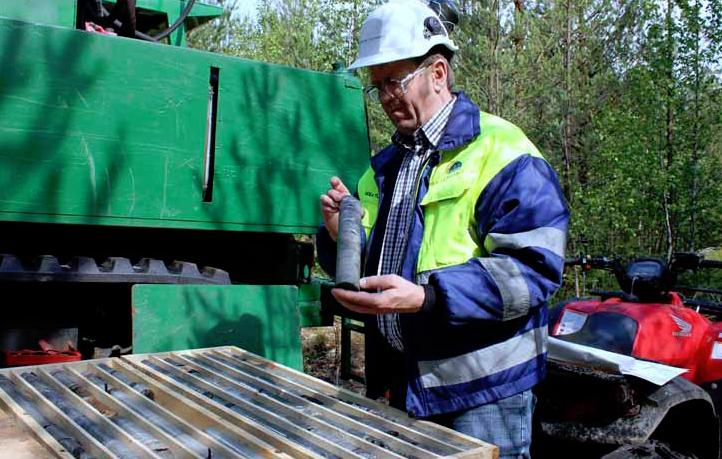
Sotkamo Silver is in the process of breathing life into the Taivaljarvi silver mine project. CEO Dr Timo Lindborg talks to Gay Sutton about building a sound investor base and the future development of the company.
The Taivaljarvi silver deposit in central Finland could well become the first primary silver mine in Europe in many generations. Discovered in 1980 and brought to the threshold of developmentat the end of the decade, the deposit is an interesting example of Finland’s unique mining history. A land of forests and lakes, Finland has traditionally been one of Europe’s largest producers of paper, a position it continues to hold today. Interestingly, though, it was those same paper companies that initiated the current trend for mineral exploration.
“During the 60s, 70s and 80s, it was common for paper mill companies to own great swathes of the forest, and at that time, many of them had geological departments,” explains Dr Timo Lindborg, CEO of Sotkamo Silver. “This area was owned by the paper company Kajaani,” a company that subsequently became part of UPM. “It was they who discovered the deposit, did some exploration and began to develop it in partnership with Outokumpu, which at that time was a large mining company.”
In the 1990s, however, the world silver markets plummeted and, having invested a considerable amount in exploration and development, Outokumpu closed down its mining interests and left the mining industry completely, transferring its business efforts to the steel industry.
Today, the Taivaljarvi silver deposit is owned by Sotkamo Silver, a Swedish company listed on the NGM Equity stock exchange in Stockholm and launched in 2005 under the name Silver Resources. “We acquired the project from Outokumpu in 2005 and launched the company specifically to develop the deposit. Our aim now is to bring the mine to production by 2013 and to become the first pure silver mining company in the Nordic countries,” Lindborg says. “There are many mines where silver is a secondary product, but at Taivaljarvi it will be the primary product, with gold secondary to it.”
Previous owners Kajaani and Outokumpu had already invested considerably in exploration and development at Taivaljarvi. “They had progressed as far as completing their mine technical planning and pre-feasibility studies—in fact, everything was ready for investment,” he continues. Around 47,000 metres of underground exploration drilling had been completed; some 2.9 kilometres of underground mine access ramps had been constructed to a depth of 350 metres below the surface; and the ventilation shafts had been excavated. “And much of their work continues to be of value to us today. By our calculations, the work would probably cost us about €15 million to do at today’s prices.”
Since taking over Taivaljarvi in 2005, Sotkamo has completed an environmental baseline study and updated the previous exploration results, bringing them up to NI 43-101 resource estimation standards by completing new quality assays on the old drill cores stored by Outokumpu. In parallel with this, new tests have verified Outokumpu’s process analysis, confirming that the ore can be concentrated on-site using flotation and shaking table methods. Much of the previous mine development plan, which had been extensive and thorough, will also be applicable today.
A new programme of exploration is attempting to explore and increase the quality of the mineral resources and gold content in it. Mineralised rock has currently been identified in an area 150 metres wide by 800 metres in length, and the degree of risk associated with the project is very low because of the density of drilling that has been undertaken.
“Geologically, there is also the potential for it to go very deep. So far, we know it goes down to 700 metres and we have verified this with drill holes, but there is nothing to tell us that it doesn’t continue below that,” says Lindborg. “We have also found that the further down we go, the better the results become.”
The previously constructed access tunnels, however, have lain dormant since the project was closed down in 1991, and have filled with water. Pumping, which began in June this year, has now passed the halfway stage. “And the good thing is that the tunnel is in very good condition, and no damage seems to have occurred during this time.”
The geological and technical challenges of bringing a mine to production are only one part of the picture. “With any mining operation in Finland, the biggest challenge is always to raise investment funding,” says Lindborg. And Lindborg is not new to these challenges—having started in 1993 as a mining consultant, he is one of Finland’s first mining entrepreneurs. “This is my third company,” Lindborg explains, “and it’s the second one that I’ve put on the stock exchange.” Having been appointed CEO of Sotkamo in May, he has used his experience to guide the company through a number of important strategic decisions.
In the spring of 2010, Silver Resources and the Swedish company Gexco merged in a so-called ‘reverse takeover’, and continued operating under the name Gexco. However, since Lindborg’s appointment in May things have moved quickly: the company has attracted two significant investors into the Taivaljarvi silver mine project—the state-owned Finnish Industrial Investments venture capital fund, and independent investment company Teknoventure Management.
Such a display of confidence from the financial sector enabled the company to attract further private investors from Sweden, bringing a total investment of some €2.7 million to the project so far. The company has also raised capital through a direct shares issue on the NGM Equity stock exchange in Stockholm
The focus of Sotkamo Silver going forward will continue to be on the Taivaljarvi project. To this end, the company’s name was changed from Gexco, which stood for ‘gold exploration company’, to Sotkamo Silver after the region of Finland in which the project is located; and the Norwegian assets of Gexco have been sold off.
The goal now is to complete the feasibility study by the end of 2011, and to begin engaging with the biggest challenge of the project—raising the funds to take the mine into production. “Sotkamo Silver has spent around €1.5 million on the work we have done so far, and we calculate that the mine will need a further investment of approximately €30 million to take it into production,” reveals Lindborg.
If everything goes according to plan, Lindborg believes that over the next 10 years, the mine will produce between 400,000 and 500,000 tons of ore with an average grade of 100 grams per ton of silver and one gram per ton of gold. Recent drilling results, however, have exceeded these quality levels by a considerable margin. “But our ultimate goal is to become a mining company,” Lindborg explains.
“I believe there is going to be some consolidation among Nordic silver and gold mining companies, and my vision is that we participate in that. And then we also have a gold deposit in the south of Finland. When we have the capacity to do so, we will start to develop that too.”













